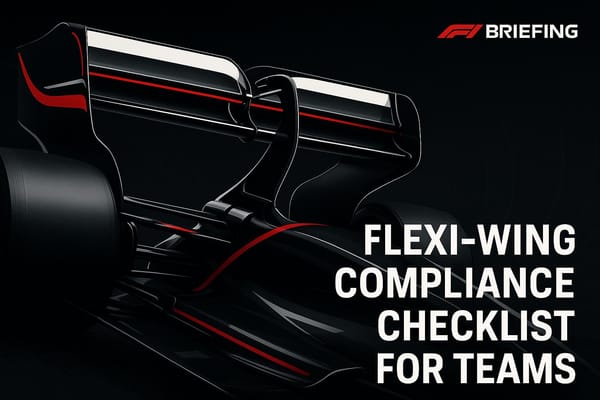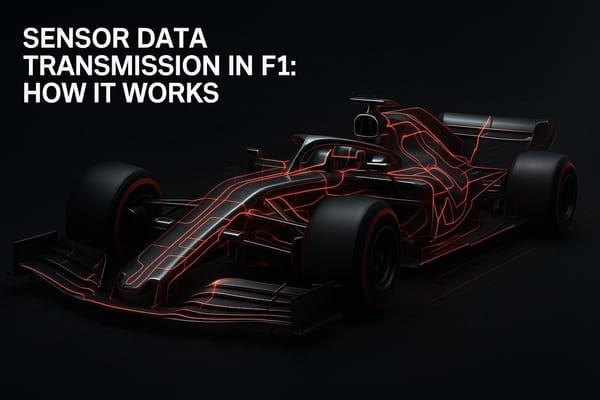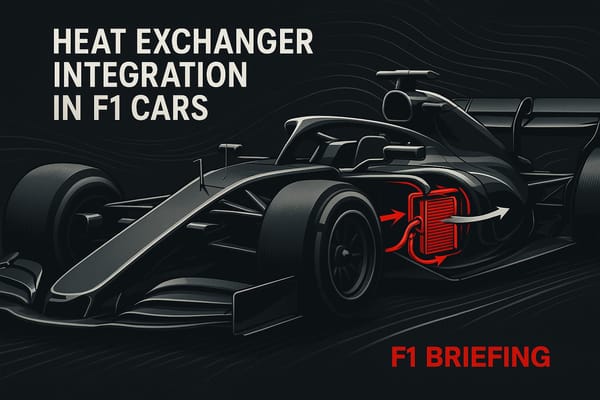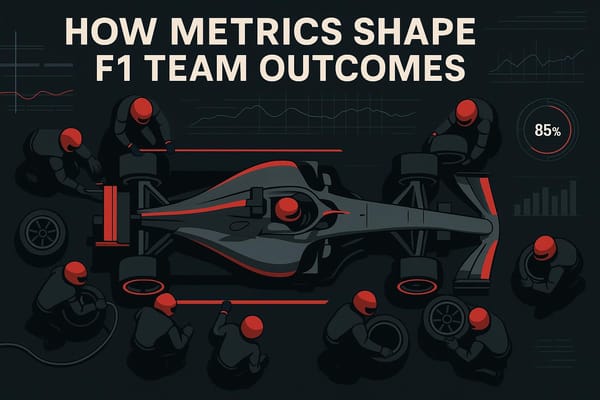8 Common F1 Racing Terms Explained for New Fans
Learn essential Formula 1 terms that enhance your race day experience, from apex strategies to the significance of podium finishes.
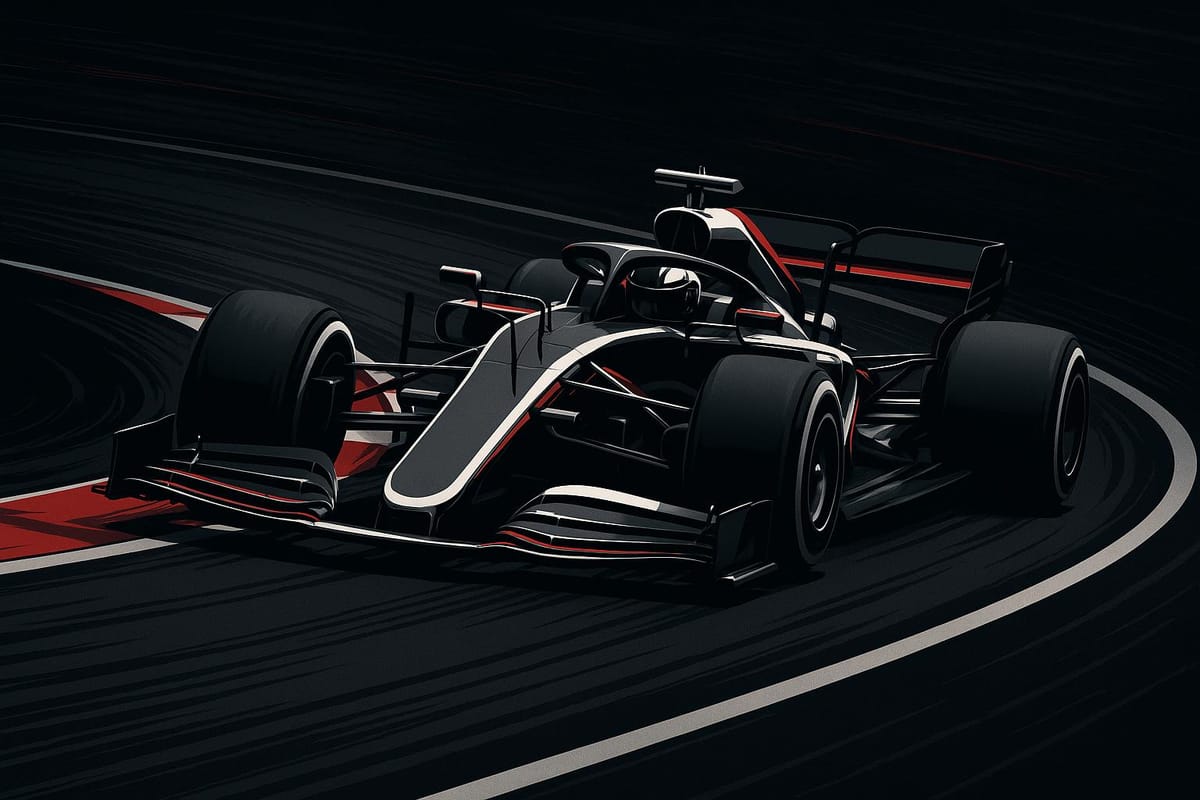
Formula 1 can be overwhelming for new fans, but understanding a few key terms can make watching races much easier. Here’s a quick rundown of 8 essential F1 terms and what they mean:
- Apex: The ideal point in a corner for maximum speed and control. Drivers adjust their strategy based on track and race conditions.
- DRS (Drag Reduction System): A rear wing flap that opens to reduce drag, increasing speed for overtaking in specific zones.
- Power Unit: The hybrid engine system combining a V6 engine with electric components for high performance and efficiency.
- Undercut vs Overcut: Pit stop strategies where drivers either pit early to gain fresh tires (undercut) or stay out longer to gain track position (overcut).
- Formation Lap: A pre-race lap to warm up tires, test systems, and prepare for the race start.
- Pole Position: The first starting spot on the grid, earned by the fastest qualifying lap.
- Podium: The top three finishers in a race, celebrated with trophies, anthems, and sparkling wine.
- Backmarker: Slower cars being lapped, which must move aside for faster cars under blue flags.
These terms are the foundation of F1 race strategy and excitement. With this knowledge, you’ll be able to follow the action and appreciate the skill and tactics behind every Grand Prix.
F1 Vocabulary Explained
1. Apex: The Racing Line's Turning Point
The apex - the innermost point of a corner - is crucial for maximizing both speed and control. Hitting it precisely shortens the racing line, directly influencing a driver's performance.
F1 drivers rely on three main types of apexes, each serving a specific purpose:
| Apex Type | Primary Use | Key Advantage |
|---|---|---|
| Geometric (Middle) | Smooth corners with balanced entry and exit | Ensures the shortest path through the turn |
| Late | Corners leading into long straights | Boosts exit speed for stronger acceleration |
| Early | Series of connected corners | Improves positioning for the next turn |
These apex strategies vary between qualifying sessions and race-day tactics.
During qualifying, drivers often opt for a late apex in corners leading to long straights, prioritizing a faster exit even if it means sacrificing entry speed. In races, apex choices shift depending on whether the driver is attacking or defending.
Here's an interesting fact: doubling your speed through a corner requires four times the turning radius. This highlights the delicate balance between speed and control.
"The apex is also a marker that helps drivers identify when to get on the power."
For new fans, watching drivers like Max Verstappen and Lewis Hamilton adapt their apex strategies - whether defending or overtaking - at legendary corners like Monaco's Grand Hotel Hairpin or Silverstone's Copse Corner is a great way to understand this skill in action.
2. DRS: How Drag Reduction System Works
The Drag Reduction System (DRS) is a movable flap on the rear wing of Formula 1 cars, introduced in 2011 to help drivers overtake by reducing aerodynamic drag. When activated, DRS increases straight-line speed, boosting top speeds by about 7–12 mph.
| DRS Component | Function | Impact |
|---|---|---|
| Detection Point | Measures the gap between cars | Determines if DRS can be used |
| Activation Zone | Specific track sections | Defines where DRS can be deployed |
| Driver Indicator | Alerts the driver | Signals when DRS is available |
| Rear Wing Flap | Mechanical part | Reduces drag when opened |
For DRS to be activated, three conditions must be met:
- The pursuing car must be within one second of the car ahead.
- Both cars must pass through a DRS detection point.
- The cars must be in a designated DRS activation zone.
These rules ensure DRS is used strategically and safely during races.
"The moment the driver starts braking for a corner, the flap automatically moves back to its original high-downforce position. We must also take into account the time it takes the flow of air to reattach, which takes about half a second."
– Laurent Mekies, Toro Rosso's chief engineer
Safety is a priority for DRS usage. The system is not available during the first two laps of a race or immediately after safety car periods. Additionally, the FIA race director can disable DRS in poor weather conditions to prioritize driver safety.
The Albert Park Circuit in Australia, for example, has four DRS zones, offering multiple overtaking opportunities and making races more unpredictable.
On race day, you can spot DRS in action when rear wing flaps open on straights as drivers close in on each other. Drivers activate DRS with a button on the steering wheel, and it automatically deactivates when they hit the brakes to maintain stability in corners.
Recent stats show that DRS can shave off up to half a second per lap and has led to an average increase of about 10 overtakes per race over the last five seasons.
3. Power Unit: The F1 Engine System
Modern Formula 1 power units are a mix of a 1.6-liter V6 turbocharged engine and hybrid technology designed to deliver exceptional performance.
| Component | Function | Performance Impact |
|---|---|---|
| Internal Combustion Engine (ICE) | Generates primary power | Around 700 horsepower |
| Motor Generator Unit - Kinetic (MGU-K) | Recovers energy from braking | Adds up to 161 horsepower |
| Motor Generator Unit - Heat (MGU-H) | Converts exhaust heat into energy | Minimizes turbo lag |
| Energy Store (ES) | Holds recovered electrical energy | Fuels the hybrid system |
| Turbocharger (TC) | Boosts engine power | Improves acceleration |
| Control Electronics (CE) | Regulates power distribution | Fine-tunes performance |
These engines can reach up to 15,000 RPM - over twice the limit of standard road cars - thanks to cutting-edge engineering, including lightweight aluminum pistons and advanced ignition systems.
The hybrid system plays a critical role. The MGU-K can recover up to 2 megajoules of energy per lap from braking, while the MGU-H contributes up to 4 megajoules by utilizing exhaust heat. This combination provides drivers with a tactical edge by reducing turbo lag and offering short bursts of extra power.
F1 engines are built for peak performance rather than endurance, typically lasting about 1,000 miles (approximately six races). They run on a synthetic fuel blend containing 90% gasoline and 10% ethanol, achieving a thermal efficiency of roughly 50%, compared to about 30% for standard road cars.
Altogether, these systems generate nearly 1,000 horsepower, with the hybrid unit alone adding an extra 161 horsepower for around 33 seconds per lap. This precision engineering is what fuels the thrilling moments seen on race day.
4. Undercut vs Overcut: Pit Stop Tactics
Pit stop tactics like undercut and overcut play a crucial role in race strategy, alongside driving skill and car performance. The timing of these stops can often determine the outcome of a race. These two strategies differ significantly in how and when they are executed.
| Strategy | Definition | Best Used When |
|---|---|---|
| Undercut | Pitting early to gain a tire advantage | High tire wear tracks, difficult overtaking |
| Overcut | Staying out longer than a rival to gain position | Low tire degradation, clean air available |
A typical pit stop takes around 20 seconds, but during safety car periods, this can drop to about 12 seconds.
The undercut strategy involves pitting earlier than competitors to capitalize on the performance boost from fresh tires. A notable example is the 2019 Singapore Grand Prix, where Sebastian Vettel pitted early from third place. His fresh tires enabled him to overtake Charles Leclerc and Lewis Hamilton.
On the other hand, the overcut strategy relies on staying out longer on worn tires to take advantage of clean air and gain track position. During the 2021 Monaco Grand Prix, after Hamilton's undercut attempt on Pierre Gasly failed, Vettel extended his stint, carefully managing his tires to execute a successful overcut.
"Race undercut and overcut strategy has played an even more important role over the last few decades, as teams and their technologies continue to evolve, the performance differentiators between cars reduces. With similar pace and performance on track, sometimes a good strategic call can be the only card teams can play to overtake the opposition."
– Catapult
Teams consider several factors when deciding between these strategies:
- Track characteristics: High tire wear tracks favor undercuts, while circuits with low degradation are better suited for overcuts.
- Weather conditions: Cooler temperatures can make warming up tires more difficult, which might make an overcut more effective.
- Traffic conditions: Clear air is essential for the success of either strategy.
- Track position: The ease or difficulty of overtaking on a specific circuit heavily influences tactical choices.
Since the refueling ban in 2010, tire performance has become even more critical, making these strategies indispensable tools in modern racing.
5. Formation Lap: The Pre-Race Warm-Up
The formation lap happens right before the race starts, giving drivers and teams a chance to confirm that everything is in working order. Think of it as a final systems check to ensure the car is ready for the intense competition ahead.
Formula 1 tires need to hit around 210°F to deliver the grip required for peak performance. To reach this temperature, drivers weave and accelerate strategically, all while evaluating the track for grip levels and spotting any potential trouble areas.
Here's a breakdown of what happens during a formation lap:
| Activity | Purpose | Key Factors |
|---|---|---|
| Tire Warming | Bring tires to their optimal temperature | Controlled weaving and acceleration |
| Brake Testing | Confirm brakes are functioning properly | Timed brake applications |
| System Checks | Ensure all components are operational | Engine, electronics, hydraulics |
| Track Assessment | Check grip levels and spot hazards | Observing track conditions |
Strict rules are in place for the formation lap to keep things safe and fair. Drivers must hold their grid positions, and overtaking is not allowed. During this lap, pit lane speed limits - typically set between 37 to 50 mph - are enforced, giving drivers time to confirm that all systems are functioning smoothly before the race begins.
Sometimes, even this warm-up lap can go wrong. At the 2025 Australian Grand Prix, rookie Isack Hajdar crashed during the formation lap, leading to an immediate retirement. This serves as a reminder of how crucial focus and control are, even in what might seem like a routine part of the race.
6. Pole Position: Starting First on the Grid
Pole position is the first spot on the Formula 1 starting grid, earned by the driver who clocks the fastest lap in the final qualifying session (Q3). Its history blends tradition with modern racing strategy.
The term "pole position" originated in horse racing in the late 19th century and transitioned into Formula 1. Giuseppe "Nino" Farina secured the sport's first-ever pole at the 1950 British Grand Prix.
Starting from pole position comes with several key advantages:
| Advantage | Impact on Race | Statistical Significance |
|---|---|---|
| Clean Air | Uninterrupted airflow when leading the pack | Over 40% of race wins come from pole |
| Track Position | Optimal line into Turn 1 | Crucial at circuits like Monaco |
| Tire Management | Better control over wear and strategy | Helps maintain an ideal race pace |
| Strategic Control | Ability to set the race tempo | Especially useful on tracks with few overtakes |
At circuits like Monaco, where passing is incredibly rare, around 75% of races are won by the pole-sitter. This makes qualifying performance just as important as race-day execution.
The margin for securing pole can be razor-thin. At the 1997 European Grand Prix in Jerez, Jacques Villeneuve, Michael Schumacher, and Heinz-Harald Frentzen all recorded identical lap times. Villeneuve claimed pole because he set his time first.
Over the years, Formula 1's qualifying format has seen major changes. Between 2003 and 2009, drivers had to qualify with their race-start fuel loads, adding a layer of strategy. Today, the focus is purely on speed. Lewis Hamilton holds the record for the most pole positions, with 104 as of the 2025 Saudi Arabian Grand Prix.
7. Podium: Top Three Race Finishers
The podium ceremony has been a hallmark of Formula 1 since 1950. It blends prestige with unique traditions, making each victory memorable.
Here’s a breakdown of the key elements in today’s podium celebrations:
| Element | Description | Purpose |
|---|---|---|
| Trophy Presentation | Trophies range from 50–65 cm for the winner, and 35–45 cm for second and third place. | Honors the drivers' achievements. |
| National Anthems | The anthems of the winning driver and constructor are played. | Highlights national pride. |
| Sparkling Wine | Ferrari Trento has been the official sparkling wine partner since 2021. | Adds to the celebratory atmosphere. |
| Team Recognition | A representative from the winning team joins the top three drivers. | Acknowledges the team's efforts. |
The tradition of spraying sparkling wine started in 1966 at Le Mans when Dan Gurney, caught up in the moment, spontaneously celebrated his victory in this now-iconic way.
"What I did with the champagne was totally spontaneous. I had no idea it would start a tradition - I was beyond caring and just got caught up in the moment. It was one of those once-in-a-lifetime occasions where things turned out perfectly. I thought this hard-fought victory needed something special."
Securing a podium spot is a major milestone, reflecting both individual skill and the team's strategy. Lewis Hamilton holds the record for the most podium finishes with 202 appearances. Max Verstappen, on the other hand, set a single-season record with 21 podiums in 2023.
Podium ceremonies also adapt to local customs. For example, in countries where alcohol consumption is restricted, sparkling fruit juice is used instead of wine. Since 2018, post-race interviews have been conducted in the parc fermé area before the podium ceremony begins.
The commercial impact of podium celebrations is considerable. Ferrari Trento, for instance, served tens of thousands of bottles during the Miami and Las Vegas Grand Prix events.
"For us, it has been a dream come true. Our brand awareness is growing, especially in the United States, where Formula 1 is rising enormously in relevance and popularity."
Next, we’ll dive into the role of backmarkers and their influence on race dynamics.
8. Backmarker: Cars Being Lapped
In Formula 1, a backmarker is a slower car that often gets lapped by race leaders. Even though they are at the back of the pack, backmarkers play a key role in shaping race dynamics and strategies.
When a faster car approaches, marshals wave a blue flag to signal the backmarker to move aside safely. This system ensures safety on the track while also impacting team strategies. Teams have to consider overtaking opportunities and pit stop timing when dealing with backmarkers.
| Situation | Required Action | Impact on Race |
|---|---|---|
| Blue Flag Shown | Backmarker must move aside safely | Reduces interference with faster cars |
| In DRS Trains | Teams adjust strategy to clear the air | Limits overtaking chances for leading drivers |
| Pit Stop Consideration | Monitor slower cars during pit stops | Helps avoid losing track position after pit stops |
The positioning of backmarkers forces teams to rethink their strategies. For example, a car on fresh tires may lose its advantage if stuck behind a slower car, affecting both on-track battles and pit decisions.
For teams and drivers, managing backmarkers effectively can make or break a race, often being the deciding factor between winning and losing in Formula 1.
Conclusion
These eight key Formula 1 terms open the door to a deeper appreciation of race-day strategies and the dynamic interplay of speed, skill, and tactics that define the sport.
Today's F1 races revolve around precise tire strategies, effective DRS usage, and well-timed pit stops. Teams rely on advanced data analysis - processing over 1,000 data points every second - to make critical decisions. Iconic races like Bahrain and Monaco highlight how these strategies shape outcomes.
| Strategic Element | Role in Race Dynamics |
|---|---|
| Tire Management | Helps predict pit stops and pace shifts |
| DRS Usage | Clarifies overtaking and positioning |
| Track Position | Stresses the value of qualifying spots |
| Race Strategy | Links pit stops to overall performance |
These elements are deeply connected, influencing every aspect of a race's outcome.
FAQs
How do different apex techniques impact a driver's performance in Formula 1?
Apex techniques play a crucial role in a driver's performance by influencing cornering speed, exit speed, and overall lap times. The apex, or the innermost point of a corner, is key to navigating turns efficiently and maintaining momentum.
Different strategies are used depending on the track layout and racing situation. A late apex is often chosen to maximize exit speed, especially when a corner leads into a long straight. This technique involves delaying the turn-in and hitting the apex later, allowing for faster acceleration out of the turn. On the other hand, a geometric apex focuses on the shortest path through a corner, connecting the entry, apex, and exit in a smooth curve. While this minimizes distance, it may not always provide the fastest exit speed.
Drivers often adapt their approach to balance speed and control, ensuring the best possible performance based on the track and race conditions.
What is DRS in Formula 1, and what are the safety rules for using it?
The Drag Reduction System (DRS) in Formula 1 is a feature that helps drivers reduce drag by adjusting the rear wing, allowing for higher speeds during overtaking. To ensure safety, DRS can only be activated in specific zones on the track, and only when a driver is within one second of the car ahead. The system automatically deactivates when the driver applies the brakes.
These restrictions are designed to prevent unsafe use of DRS, particularly in corners or high-risk areas, ensuring fair competition while maintaining driver safety.
How do F1 teams decide between using an undercut or overcut strategy during a race?
In Formula One, teams choose between an undercut or overcut strategy based on track conditions, tire performance, and race dynamics.
- Undercut: This involves pitting earlier than a competitor to gain an advantage from fresh tires. It’s particularly effective on tracks with high tire wear or where overtaking is difficult.
- Overcut: This strategy keeps a driver on track longer than a competitor, aiming to gain track position while the competitor pits. It works well on circuits with low tire degradation or when clean air can be used to maintain strong lap times.
The decision depends on factors like tire degradation rates, track layout, and real-time race conditions, making it a critical part of F1 strategy.

